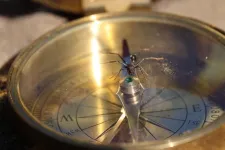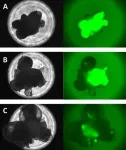(Press-News.org) About The Study: In this cross-sectional study of 52,000 participants representing 264 million U.S. adults, population-level improvements in total cholesterol and triglyceride levels decelerated and adverse trends in glucose levels accelerated in more recent birth cohorts, which was partially mediated by concurrent increases in body mass index. Public health initiatives that target antecedent health behaviors are needed to improve cardiometabolic health across generations.
Corresponding Author: To contact the corresponding author, Xiaoning Huang, PhD, email jack.huang@northwestern.edu.
To access the embargoed study: Visit our For The Media website at this link https://media.jamanetwork.com/
(doi:10.1001/jamanetworkopen.2024.49481)
Editor’s Note: Please see the article for additional information, including other authors, author contributions and affiliations, conflict of interest and financial disclosures, and funding and support.
# # #
Embed this link to provide your readers free access to the full-text article This link will be live at the embargo time http://jamanetwork.com/journals/jamanetworkopen/fullarticle/10.1001/jamanetworkopen.2024.49481?utm_source=For_The_Media&utm_medium=referral&utm_campaign=ftm_links&utm_term=120624
About JAMA Network Open: JAMA Network Open is an online-only open access general medical journal from the JAMA Network. On weekdays, the journal publishes peer-reviewed clinical research and commentary in more than 40 medical and health subject areas. Every article is free online from the day of publication.
END
Cholesterol, triglyceride, and glucose levels across birth cohorts in the US
JAMA Network Open
2024-12-06
ELSE PRESS RELEASES FROM THIS DATE:
Desert ants use the polarity of the geomagnetic field for navigation
2024-12-06
Desert ants of the Cataglyphis nodus species use the Earth's magnetic field for spatial orientation, but these tiny insects rely on a different component of the field than other insects, a research team led by Dr Pauline Fleischmann from the University of Oldenburg, Germany, reports in the journal Current Biology. As the team explains in its paper, this suggests that they also use a different mechanism for magnetoreception than most insects studied to date, including, for example, the famous monarch butterflies. The researchers suspect that magnetoreception in these desert ants is based on a mechanism involving ...
A breakthrough tool for detecting problems during protein synthesis
2024-12-06
In eukaryotic cells—found in animals, plants, and fungi—protein synthesis involves more than the simple assembly of amino acids in ribosomes. Nearly one-third of all human proteins must be transported to the endoplasmic reticulum (ER) during or shortly after their synthesis. In the ER, these proteins undergo crucial folding and modifications, including the formation of disulfide (S–S) bonds, which are vital for their structure and function.
Disruptions in protein translocation to the ER or disulfide bond formation underlie several diseases, and understanding the mechanisms that govern these processes is essential in biology and medical ...
Rapid ascend: COMMTR's three-year journey to SCIE and SSCI inclusion
2024-12-06
We are thrilled to announce that our esteemed academic journal, Communications in Transportation Research (COMMTR), has been officially included in both the Science Citation Index Expanded (SCIE) and the Social Sciences Citation Index (SSCI) by Web of Science, a leading global provider of scientific and scholarly research information.
In the Journal Citation Reports (JCR) released in June 2024, COMMTR received its first Impact Factor of 12.5, ranking it 1st among 58 journals in the TRANSPORTATION category and 3rd among 72 journals in the TRANSPORTATION SCIENCE & TECHNOLOGY category. The dual inclusion in SCIE and SSCI signifies that the journal has ...
Getting a grip on health norms
2024-12-06
Convenient, safe, and non-invasive, ‘handgrip strength’ is a reliable predictor for age-related disease and disability.
Now, a groundbreaking study led by the University of South Australia and conducted in collaboration with 140 authors across the globe, has created the world’s largest and most geographically comprehensive international norms for handgrip strength, enabling global peer-comparison, health screening and surveillance across the adult lifespan.
Published in The Journal of Sport and Health Science ...
Living in a disadvantaged neighborhood linked to higher blood pressure and lower cognition
2024-12-06
WINSTON-SALEM, N.C. – Dec. 6, 2024 – New research from Wake Forest University School of Medicine suggests that living in a disadvantaged neighborhood is associated with higher blood pressure and lower cognitive scores, even among people who do not have an existing diagnosis of mild cognitive impairment.
The study appears online today in Alzheimer’s & Dementia: Diagnosis, Assessment & Disease Monitoring, a journal of the Alzheimer’s Association.
“We know that inequitable access to education, employment, income and housing increases the risk for Alzheimer’s disease and related dementias,” said James R. Bateman, M.D., ...
Bird-inspired drone can jump for take-off
2024-12-06
“As the crow flies” is a common idiom referring to the shortest distance between two points, but the Laboratory of Intelligent Systems (LIS), led by Dario Floreano, in EPFL’s School of Engineering has taken the phrase literally with RAVEN (Robotic Avian-inspired Vehicle for multiple ENvironments). Designed based on perching birds like ravens and crows that frequently switch between air and land, the multifunctional robotic legs allow it to take off autonomously in environments previously inaccessible to winged drones.
“Birds were the ...
AI beats experts in predicting future quality of “mini-organs”
2024-12-06
Fukuoka, Japan – Organoids—miniature, lab-grown tissues that mimic organ function and structure—are transforming biomedical research. They promise breakthroughs in personalized transplants, improved modeling of diseases like Alzheimer’s and cancer, and more precise insights into the effects of medical drugs.
Now, researchers from Kyushu University and Nagoya University in Japan have developed a model that uses artificial intelligence (AI) to predict organoid development at an early stage. The model, which is faster and more accurate than expert researchers, ...
A new biodegradable material to replace certain microplastics
2024-12-06
CAMBRIDGE, MA -- Microplastics are an environmental hazard found nearly everywhere on Earth, released by the breakdown of tires, clothing, and plastic packaging. Another significant source of microplastics is tiny beads that are added to some cleansers, cosmetics, and other beauty products.
In an effort to cut off some of these microplastics at their source, MIT researchers have developed a class of biodegradable materials that could replace the plastic beads now used in beauty products. These polymers break down into harmless sugars and amino acids.
“One way to mitigate the microplastics problem is to figure out how to clean up existing ...
Speaking crystal: AI learns language of atom arrangements in solids
2024-12-06
A new artificial intelligence model that can predict how atoms arrange themselves in crystal structures could lead to faster discovery of new materials for everything from solar panels to computer chips.
The technology, called CrystaLLM, was developed by researchers at the University of Reading and University College London. It works similarly to AI chatbots, by learning the "language" of crystals by studying millions of existing crystal structures.
Published today (Friday, 6 December) in Nature Communications, the new system will be distributed to the scientific community to aid the discovery of new materials.
Dr ...
3D scans of giant hailstones reveal surprising discoveries that could help predict future storms
2024-12-06
Hailstones are formed during thunderstorms, when raindrops are propelled into very cold parts of a cloud, where they freeze. Once the particles are heavy enough, gravity pulls them back towards Earth. As the plummet, they grow into hailstones, which can cause injury to people and significant damage to homes and cars.
Scientists have been studying how hailstones grow since the 1960s but doing so meant breaking them in the process. To better understand the anatomy and growth of hailstones, researchers in Catalonia have used computed tomography (CT) scans to examine the giant hailstones that hit the north-east of the Iberian Peninsula during an exceptionally strong thunderstorm ...
LAST 30 PRESS RELEASES:
Reducing social isolation protects the brain in later life
Keeping the heart healthy increases longevity even after cancer
Young adults commonly mix cannabis with nicotine and tobacco
Comprehensive review illuminates tau protein's dual nature in brain health, disease, and emerging psychiatric connections
Book prepares K-12 leaders for the next public health crisis
Storms in the Southern Ocean mitigates global warming
Seals on the move: Research reveals key data for offshore development and international ecology
Sports injuries sustained during your period might be more severe
World's first successful 2 Tbit/s free-space optical communication using small optical terminals mountable on satellites and HAPS
Can intimate relationships affect your heart? New study says ‘yes’
Scalable and healable gradient textiles for multi‑scenario radiative cooling via bicomponent blow spinning
Research shows informed traders never let a good climate crisis go to waste
Intelligent XGBoost framework enhances asphalt pavement skid resistance assessment
Dual-function biomaterials for postoperative osteosarcoma: Tumor suppression and bone regeneration
New framework reveals where transport emissions concentrate in Singapore
NTP-enhanced lattice oxygen activation in Ce-Co catalysts for low-temperature soot combustion
Synergistic interface engineering in Cu-Zn-Ce catalysts for efficient CO2 hydrogenation to methanol
COVID-19 leaves a lasting mark on the human brain
Scientists use ultrasound to soften and treat cancer tumors without damaging healthy tissue
Community swimming program for Black youth boosts skills, sense of belonging, study finds
Specific depressive symptoms in midlife linked to increased dementia risk
An ‘illuminating’ design sheds light on cholesterol
Who is more likely to get long COVID?
Study showcases resilience and rapid growth of “living rocks”
Naval Research Lab diver earns Office of Naval Research 2025 Sailor of the Year
New Mayo-led study establishes practical definition for rapidly progressive dementia
Fossil fuel industry’s “climate false solutions” reinforce its power and aggravate environmental injustice
Researchers reveal bias in a widely used measure of algorithm performance
Alcohol causes cancer. A study from IOCB Prague confirms damage to DNA and shows how cells defend against it
Hidden viruses in wastewater treatment may shape public health risks, study finds
[Press-News.org] Cholesterol, triglyceride, and glucose levels across birth cohorts in the USJAMA Network Open





